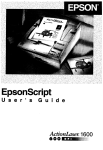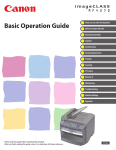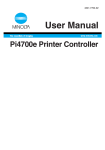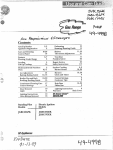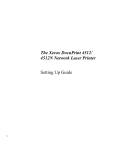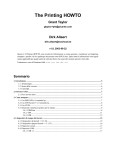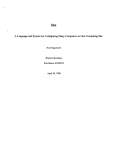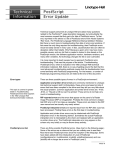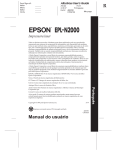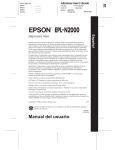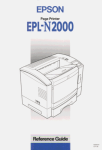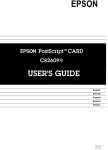Download Epson C83202 User`s guide
Transcript
EPSON English 4002619 CO1-00 EPSON EpsonScript™ Cartridge RI C83202* Macintosh User’s Guide All rights reserved. No part of this publication may be reproduced, stored in a retrieval system, or transmitted in any form or by any means, mechanical, photocopying, recording, or otherwise, without the prior written permission of Seiko Epson Corporation. No patent liability is assumed with respect to the use of the information contained herein. Neither is any liability assumed for damages resulting from the use of the information contained herein. Neither Seiko Epson Corporation nor its affiliates shall be liable to the purchaser of this product or third parties for damages, losses, costs, or expenses incurred by purchaser or third parties as a result of: accident, misuse, or abuse of this product or unauthorized modifications, repairs, or alterations to this product, or (excluding the US) failure to strictly comply with Seiko Epson Corporation’s operating and maintenance instructions. Seiko Epson Corporation shall not be liable against any damages or problems arising from the use of any options or any consumable products other than those designated as Original Epson Products or Epson Approved Products by Seiko Epson Corporation. The EpsonScript Level 2 Cartridge is a customized product based on PhoenixPage Level 2 developed by Phoenix Technologies Ltd. Epson is a registered trademark of Seiko Epson Corporation. TrueType, AppleTalk, Macintosh, and LaserWriter are registered trademarks of Apple Computer, Inc. ITC Avant Garde, ITC Bookman, ITC Zapf Chancery, ITC Zapf Dingbats are registered trademarks of International Typeface Corporation. Bookman and Century Schoolbook are registered trademarks of Kingsley-ATF Type Corporation. Times, Helvetica, Helvetica Narrow, and Palatino are registered trademarks and New Century Schoolbook is a trademark of Linotype AG and/or its related companies. Phoenix, PhoenixPage, and Phoenix MultiGray are registered trademarks of Phoenix Technologies Ltd. PostScript is a registered trademark of Adobe Systems, Inc. General notice: Other product names used herein are for identification purposes only and may be trademarks of their respective owners. Epson disclaims any and all rights in those marks. EpsonScript Driver, Copyright © 1992,1993 PhonixPage PS2 Driver, Copyright © 1992,1993 COMPUTER:applications,Inc., Copyright © 1988-1993 All Right Reserved Copyright ©1993 by Seiko Epson Corporation Nagano, Japan Contents Introduction Features.. . . . . . . . . . . . . . . . . . . . . . . . . . . . . . . . . Before using EpsonScript . . . . . . . . . . . . . . . . . . . . . . . . Available interface . . . . . . . . . . . . . . . . . . . . . . . . . Required memory . . . . . . . . . . . . . . . . . . . . . . . . . Applications NOT supported . . . . . . . . . . . . . . . . . . Chapter 1 1 2 2 2 3 Installing the Programs Installing the printer driver . . . . . . Before installing . . . . . . . . . Easy and customize installation Using Easy installation . . . . . Customize installation . . . . . ................. ................. ................. ................. ................. 1-1 1-1 1-2 1-2 1-5 Chapter 2 Setting Up Your Macintosh Using Chooser to Set Up Your Printer . . . . . . . . . . . . . . . . . Selecting EpsonScript . . . . . . . . . . . . . . . . . . . . . . . Making settings in Page Setup . . . . . . . . . . . . . . . . . . . . Renaming the Printer . . . . . . . . . . . . . . . . . . . . . . . . . . Running the EpsonScript Utility . . . . . . . . . . . . . . . . . Print Dialog . . . . . . . . . . . . . . . . . . . . . . . . . . . . . . . . Tips on Using TrueType Fonts . . . . . . . . . . . . . . . . . . . . . Chapter 3 2-1 2-1 2-2 2-10 2-10 2-12 2-17 Using the EpsonScript Driver Utility Operation outline . . . . . . . . . . . . . . . . . . . . . . . . . . 3-1 iii Utility Functions . . . . . . . . . . . . . . . . . . . . . . . . . . . 3-3 PostScript Printers/ AppleTalk Zones . . . . . . . . . . . . . . 3-3 Printer is silent (box) . . . . . . . . . . . . . . . . . . . . . . . 3-3 Update Lists (Button) . . . . . . . . . . . . . . . . . . . . . . . 3-4 Information. . . . . . . . . . . . . . . . . . . . . . . . . . . . . 3-4 Print Requested Info (box) . . . . . . . . . . . . . . . . . . . . 3-4 Font Options . . . . . . . . . . . . . . . . . . . . . . . . . . . . 3-4 Printer Options. . . . . . . . . . . . . . . . . . . . . . . . . . . 3-4 About (button) . . . . . . . . . . . . . . . . . . . . . . . . . . . 3-5 Font Options . . . . . . . . . . . . . . . . . . . . . . . . . . . . . 3-5 List Fonts (button) . . . . . . . . . . . . . . . . . . . . . . . . . 3-5 Download (button) . . . . . . . . . . . . . . . . . . . . . . . . 3-5 Remove (button) . . . . . . . . . . . . . . . . . . . . . . . . . 3-10 Printer Options . . . . . . . . . . . . . . . . . . . . . . . . . . . . . . 3-11 Printer Info (button) . . . . . . . . . . . . . . . . . . . . . . . . 3-12 Send File (button) . . . . . . . . . . . . . . . . . . . . . . . . . 3-14 Rename (button) . . . . . . . . . . . . . . . . . . . . . . . . . . 3-15 General (button) . . . . . . . . . . . . . . . . . . . . . . . . . . 3-16 Features The EpsonScript™ driver gives your Epson printer the capability to print out documents formatted for PostScript™ Level 2 printers (equivalent to the Apple® Personal Laser Writer-2g) with your Macintosh® computer. This driver provides you with the following high performance features, for use with today’s desktop publishing: Q Printing of documentations for PostScript printers. You can easily print text, line art, graphics, and so on. With this cartridge installed, your Epson printer works as if it is an Apple Laser Writer 2g. iJ 35 fonts in 11 font families: Fixed Pitch 810 Courier, Dutch 801 Roman, Swiss 721, Geometric ITC AvantGarde, Revival 711 ITC Bookman, Swiss 721 Narrow, Century 702 Century Schlbook, Zapf Calligraphic 801, ITC Zapf Chancery Medium Italic, ITC Zapf Dingbats, and Symbol. Q Epson quality, reliability, and ease of operation. This manual is a supplement to your printer manual. It gives you the additional information necessary to use the EpsonScript cartridge with your printer. Store these manuals together. Introduction 1 Before using EpsonScript Available interface By connecting your Macintosh using Epson’s optional LocalTalk interface C82312*, you can use EpsonScript with your Macintosh computer. (If your printer has a built-in LocalTalk interface, you can use it instead.) Note: 0 Do not use the serial interface for this purpose, because the Macintosh does not have a printer driver for the serial interface. 0 This cartridge cannot be used in the EPL4000/4100/4200, EPL-7000, or EPL-8000/8100 printers. Also, this cartridge does not work with any other printers even if the printer has a cartridge slot. Please contact your dealer for details on whether you can use this cartridge with later Epson printers than those listed in this manual. 0 This cartridge does not work if the optional Epson PostScript CARD (C82609*) is installed in your printer. Required memory Before using this cartridge, make sure your printer has more than 1.5MB of memory. Because this cartridge generates printing data using banding memory techniques, you should be able to print out most documents without adding more memory. If you connect your printer to more than one computer, you must assign at least 1.5MB of printer memory to the channel using the cartridge. (See your user’s guide for more details.) However, it is recommended you increase your printer’s memory if you print documents that require large amounts of data, such as detailed graphics or complex layout formats. 2 Introduction Note: 0 You cannot assign the PostScript mode to more than one channel, even if your printer has more than 3.OMB of memory. 0 When memory is insufficient for your document, the printing process is canceled. If this occurs, install extra memory in your printer. Applications NOT supported Applications listed below are not supported: LaserTalk™ SmartArt™ Introduction 3 Chapter 1 Installing the Programs This chapter explains how to install the printer software on your Macintosh computer. Before installing this software, install the EpsonScript hardware in your printer according to the instructions in your User’s Guide. You can install this software using the installer programs included in the disk packed with the EpsonScript package. This installer copies the printer driver, utility, driver supplement files, and screen fonts to your Macintosh computer. Installing the printer driver Before installing To install the software, your Macintosh computer must have the following: ~3 2MB of RAM Q (minimum; varies depending on the minimum size required by your system) System 7.0 or later 0 Hard disk Caution: Do not use the installerfor System 6.x or earlier. use this installer for these old systems, your system will be corrupted. Installing the Programs If you 1-1 Easy and customize installation The installer has two installation types; Easy Installation and Customize Installation. The characteristics of each installation are described below. Easy installation The installer copies all files which did not exist in your computer’s hard disk drive. This choice is recommended for most of the all users. Customize installation At the beginning of this installation, you can select the file(s) to be installed to your computer so you can save the hard disk space. However, we recommend you to start Easy Installation described above, because the utility program and the screen fonts revise your printing environment drastically better. Using Easy installation Follow the steps below to install the necessary files for using EpsonScript with your computer: 1. Turn on your Macintosh computer. Note: If your Macintosh runs any applications automatically when the power is turned on, quit the application before running the installer. 2. Insert Disk1 (Installation) into your computer. The Printing Tools window opens automatically. 3. Double click the “Installer” icon in the “Printing Tools” window. The following window appears on your display: 1-2 Installing the Programs EPSON Printing tools & Screen Fonts Installer EpsonScript Printer Driver PPD files for the EPSON printers. EpsonScript Printer Utility Screen Fonts 4. Click OK. The installer then shows the menu below: easy Install Click Install to place the l EpsonScript Driver l EpsonScript Utility l Screen Fonts for System 7.1 on the hard disk named 0 HD-SCSI 0 Note This sample is based on your running the installer using System 7.1, and your current hard disk being HD-SCSI 0. The hard disk name, the System name, and the items below “Click Install to place the” vary according to your system environment. Installing the Programs 1-3 5. Make sure the name of the hard disk on you would like to install the programs is shown below the message “on the hard disk named” (where HD-SCSI 0 appears in the example). If the hard disk name is correct, go to step 7. 6. Click Switch Disk. Then one of other hard disk names is displayed. Click again until you see the desired hard disk name. 7. Click Install to perform the easy installation. The installer starts copying the necessary files automatically. 8. Change the disk from Printing Tools (Disk1 ) to Screen Fonts (Disk2) when the installer instructs you to do so. Installer continues copying files automatically after you insert the next disk. Note: You need to exchange the disks several times, as the messages indicate. 9. Make sure the following message shows on your display. Installation on the active startup disk “HD-SCSI 0” was successful. You must now restart your Macintosh to use your new software. 10. Click Restart. You are now finished copying files from the disk 3. 1-4 Installing the Programs Note : If the screen fonts have already been installed, the following message appears in step 9. Click Quit to leave the installer if this occurs. Installation on “HD-SCSI 0” was successful. If you are finished, click Quit to leave the Installer. If you wish to do additional installations, click Continue. To enable the printer drivers, follow the instructions in the next chapter, “Setting Up Your Macintosh.” Customize installation Note: You can copy only the files you need from the disks using this installation method. If you cannot print correctly after this installation, perform the Easy Installation to copy the necessary files and modify your system settings. Steps 1 to 6 are the same as the steps in the Easy Installation. Follow the steps in that section first. From step 7, follow the procedures below: 7. Click Customize to open the Customize Installation window. The Customize Installation window is displayed. Installing the Programs 1-5 Click the items you went to select; Shift-click to select multiple items. Note: You can return to the Easy Installation by clicking Easy Install. 8. Click the item(s) you would like to install. Selected items are displayed in reverse, and the product information is shown. For example, if you click EpsonScript Driver, the window changes as follows: Click the items you want to select; Shift-click to select multiple items. 1-6 Installing the Programs Note: You can select multiple items by dragging the mouse or clicking the next item while pressing the shift key. Product information is shown when you select a single item only. 9. After you select the items, click Install. The installer starts copying the necessary files automatically. 10. If you install the screen fonts, eventually a message appears requesting you to change the disk. Change the disk from Printing Tools (Disk1) to Screen Fonts (Disk2) as instructed by the installer messages. Installer continues copying files automatically after you insert the required disk. Note: You will need to exchange the disks several times, as the messages indicate. The following steps are the same as the previous “Easy Installation” section. Follow from step 9 on in that section to complete installation. Installing the Programs 1-7 Chapter 2 Setting Up Your Macintosh To use EpsonScript, you need to select your printer using Chooser. After you choose the settings in Page Setup..., you can start printing using your EpsonScript printer. When you are connecting two or more Epson printers of the same model using AppleTalk, you must rename the printer to distinguish it from the other printers. In this case, follow the steps in the “Rename the Printer” section. Using Chooser to Set Up Your Printer Selecting EpsonScript 1. Press on the Apple menu and hold down. Then drag down to Chooser. The Chooser window displays. APPleTelk Zones: ~~ App’eTa’k @Active 0 Inact$ve 7 : Setting Up Your Macintosh 2-1 2. Click EpsonScript Driver in Chooser. 3. Click the AppleTalk zone your printer is connected to in the AppleTalk Zones list. If your computer is connected to only one AppleTalk zone, ignore this step. 4. Click the printer name displayed in the box on the right side of the window. 5. Click Setup to select your printer. 6. Click the Selected PPD popup list. Then drag the mouse to your printers name. Make sure the selected printer name is displayed correctly in the Selected PPD list. 7. Click OK to save the new setting. Note: If you are using other PostScript or EpsonScript printers on your AppleTalk network, they are also displayed in the list. Note for Background Printing: You can select the background printing feature that allows you to proceed with other work while your computer performs printing in the background. To enable this feature, click the On radio button. Refer to your computer’s user’s guide for more details. 8. Click Close in Chooser. The system then displays a caution message warning that you need to make settings in Page setup . 9. Click OK to close the caution window. Making settings in Page Setup... Before you start printing, you need to adjust the software settings to match your actual printer settings, especially the paper size and orientation. 2-2 Setting Up Your Macintosh 1. Select Page Setup... in the File menu. The following window is displayed. EpsonScript Driuer ” ActionLaser I ooo * Paper: 1 letter 2. % n [ C a n c e l ] -1 Layout: Il-Up[ Reduce or Enlarge: S~by’D~Q Orientation: [Options] [Help] [About) Make the settings for your printer and click OK. The meaning of each option is described below. The current settings are reflected in the paper image displayed at the left of the window. The following sections describe the settings available in Page setup. Paper (popup menu) You can select a paper size using this option. You can choose any paper size listed in the option. Make sure this setting matches the paper loaded in your printer. You can select from among these paper sizes: A4, A5, B5, Letter, Legal, HalfLetter, Executive, GovernmentLegal, GovernmentLetter, F4, Monarch, Commercial-10, DL, C5 The default value varies, depending on your printer’s PPD file setting. Usually A4 or Letter is selected. Note: The available paper sizes my depending on the PPD file prepared for your printer. Setting Up Your Macintosh 2-3 Orientation (icons) You can select the direction of the document printed on the paper. To change the orientation, click on the icon. The default value is portrait (icon on the left.) Reduce or Enlarge (box) You can reduce or enlarge your document from 25% to 400%. Enter the number of the percent you would like to reduce or enlarge. The default value is l00(%.) Layout (popup menu) You can print two or more pages of your document onto one sheet of paper. Each page is reduced and the selected number of pages is printed on one sheet. For example, if you choose 4-UP, every four pages of your document are printed on one sheet. You can select l-up, 2-UP, 4-UP, 6-UP, 8-up, 9-up, 12-up, or 16-up. The default value is l-up. Cancel (button) Click this button to cancel the setting changes and exit the current window. All changes you made are canceled and the settings return to their values before you entered this window. About (button) You can see the information about this driver by clicking this button. To exit the About window, click anywhere on the window. Help (button) Click this button to view the help document for the driver. You can use the help list at the left of the window. To exit the Help window, click Done on the right of the window. 2-4 Setting Up Your Macintosh Options (button) You can change the advanced settings for your printer using this option. This option includes four menus, and each menu has several items. The items are listed below. General Banner Page, Encoding, Date/Time Stamp Banner Page The default value is None. Other options are First and Last. The banner page is a sheet printed to identify the print job in a network environment. This page displays the user name, printing date and time of the print job. If First or Last is selected, the banner page is printed at the first or last of the document. Encoding The default value is Binary. The other option is ASCII. This option is enabled when you save the document as a PostScript file to your disk. You can reduce the quantity of the data by selecting the Binary option. If you would like to edit the data using an editor, save it as an ASCII file. Date/Time Stamp You can print the printing date and time at the top of each page using this option. To enable this feature, click the check box. This feature is disabled as the default setting. Visual Effects Flip Horizontal, Flip Vertical, Invert Image, Print Patterns As Grays, Smart Underlining, Precision Bitmaps, Fonts You can adjust the document using this feature. The following window opens when you select the Visual Effects in the list: Setting Up Your Macintosh 2-5 0ptk.n Groups: 0 Flip Horizontal 0 Flip Uertical 0 lnuert Image q Print Patterns Rs Grays 0 Smart Underlining /yYQY 0 Precision Bitmlps r-1 [fonllJ [ m Flip Horizontal/Flip Vertical These options allow you to flip the printed image on the page. To enable these settings, click the appropriate check box. Invert Image When this check box is clicked, you can invert the black and white (or color) of your document. Print Patterns As Grays (/As Colors) Bitmap graphic images can be black and white, color, or simulated grayscale using black and white patterns to represent shades of gray. The driver sends these patterns to the printer as colors so that the printer can print them in its own grayscale patterns. But some patterns used in graphics may not be recognized by the driver as representing color. These are sent to the printer as patterns and therefore have a poorer quality. This option tells the driver to send all patterns to the printer as colors so the print quality of each pattern can be matched to the printer’s capabilities. This item depends on your printers PPD file. AS Gray appears if the PPD is prepared for a black and white printer, and AS Colors appears for a PPD that is prepared for a color printer. 2-6 Setting Up Your Macintosh Smart Underlining Normally, the underlining crosses the descenders in your documents. You can break the underlining around the decenders using this setting. You can confirm the setting by viewing the sample graphic in the window. Precision Bitmaps On most Macintosh computers, images are displayed at 72 dpi (dots per inch). However, most EpsonScript and PostScript printers print images at multiples of 75 dpi. This might decrease the image print quality during transformation of screen data to print data. Click this button to multiply the images at a multiple of 75 dpi. The quality of the image is preserved, though the image is reduced by about 4% from the screen size. Fonts You can manage the font environment for your printer using this button. You can see the following window after you click the Fonts button: System Fonts PPWlnstalled Fonts [ (Remo.eJ Bookmun~-Oeml Bookmnn-ilemiltslic (Help] 0 Substitute Fonts TrueTgpe Fonts: 1 Convert to Tupe 1 ~1 Include Fonts: [ All But PPg/lnstalled ~1 [CanEsl] [Saue] Setting Up Your Macintosh 2-7 Note: You should be familiar with font management on a Macintosh computer before you attempt to changefont settings. System Fonts (list) Displays the list of available fonts to be added to the PPD/lnstalled Fonts list. PPD/lnstalled Fonts (list) Displays the fonts found in the PPD file and those added from the System Fonts list to be saved in the PPD file. Substitute Fonts (check box) Click this check box to substitute common screen fonts with similar printer fonts. By not downloading the printer fonts from your computer, you can print faster than when using screen fonts. Note that if the substituted font design is very different, your document can vary drastically from the screen. TrueType Fonts: (popup menu) The default value is Convert to Type 1. The other option is Keep as TrueType. Include Fonts: (popup menu) The default value is All But PPD/lnstalled. Other options are None, All, All But Standard 13, and All But Standard 35. Add-> (button) Click this button to add the fonts selected in the System Fonts list to the PPD/lnstalled Fonts list. Remove (button) Click this button to remove the fonts selected in the PPD/lnstalled Fonts list. 2-8 Setting Up Your Macintosh Save (button) Click this button to save the current fonts listed in the PPD/lnstalled Fonts list to the PPD file. After saving the data, the current window closes and you return to the previous window. Cancel (button) Click this button to cancel the settings you changed and exit the current window. All changes you made are canceled and the settings return to their values before you entered this window. Help (button) Click this button to view the help document for the driver. You can use the help list at the left of the window. To exit the Help window, click Done at the right of the window. Resolution Improve Resolution Improve (popup menu) You can change your Epson printer’s RITech (Resolution Improvement Technology) setting using this feature. The default value is Printer’s default. Printer’s default RITech setting is used according to the printers setting. Off/light/Medium/Heavy RITech is set to Off/Light/Medium/Heavy. Note: The RITech feature is supported on certain Epson printers only. This setting does not affect other brand printers that have a similar feature. Setting Up Your Macintosh 2-9 Dot Screen Dot Screen (popup menu) You an change the grayscale technology setting using this feature. If your printer supports the Phoenix MultiGray feature, set this option to MultiGray. The Standard option sets the printer’s grayscale handling to be the same as the standard PostScript feature. The default value is Printer’s default. Renaming the Printer If your EpsonScript printer is the only EpsonScript printer and no other PostScript printer is connected to your AppleTalk network, you may not need to rename the printer name. When several EpsonScript or PostScript printers are connected to your AppleTalk network, you should rename the printer name to distinguish your printer from others. To rename the printer, use the EpsonScript Utility according to the steps below. Running the EpsonScript Utility 1. Open your hard disk window. 2. Double click EpsonScript Utility. Note: If you cannot find the EpsonScript Utility in your hard disk window, perform the easy installation according to the steps in Chapter 1. 2-10 Setting Up Your Macintosh 3. The following window is displayed. Make sure your printer’s name is shown in the list at the upper left comer. r IJDdate Rbout Lists 1 4. Click your printer’s name. 5. Click Rename at the right side of the window. The following window appears: Near name for “Actionlaser 1 IlOCI”: Printer Status : ~ . . . . . . . . . . . . . . . . . . . . . . . . . . . . . . . . . . . . . . . . . . . . . . . . . . . . . . . . . . . . . . . . . . . . . . . . . . . . . . . . . . . . . . . . . . . . . . . . . . . . . . . . . . . . . ................................................. ........... : t................._....................................................................................................................................................... Note : Not all printers change their names immediately. You may, need to wait a minute or even turn the printer off and on before clicking the ‘Update Lists’ button on the main window to update the zone/printer lists. [Cancel] : [Ok] Setting Up Your Macintosh 2-11 6. Enter a unique name for your EpsonScript Printer. 7. Click OK. 8. Click the Close box. Note: The features of the EpsonScript Utility are explained in Chapter 3. Print Dialog After you set up your computer, you can print using the EpsonScript driver. When you select print in your software, the following screen appears: EpsonScritbtBrier Copies:m I ” ActionLasrr I ooo ” S+= 4 puipr@~ Pages: @I RII 0 From: 0 To: 0 Print As: 0 B/W @ GraYscale Print To: @I Printer 0 File [Cancel] Printer Prep: 1 Temporary -1 [Options] paper from.. [ H e l p ] [ A u t o m a t i c -1 :“““““““““‘““” _. . ,. _ .-.-. 7 0 Couer In: j fluttrrntrt~c [lbout] Print Pages: @I All 0 Odd Pages Only 0 Even Pages Only Section Range: From: I To: I 0 Print Selection Only IJ Print Neut File 0 Print Back To Front 0 Print Hidden TeHt This menu includes the following items: Copies, Pages, Print As, Print To, Printer Prep, Paper from, Cover In, Print, Cancel, Options, Help, About 2-12 Setting Up Your Macintosh copies (box) Enter a number from 1 to 999 to generate multiple copies of your document. The default value is 1. Pages You can specify the pages of your document to print. The default setting is All, displayed by the All button. You can enter the page numbers in the boxes From: and TO:. The available range for the boxes is from 1 to 9999. Print As You can select the printout method from B/W, Color (if available on your printer), or Grayscale. The default setting is B/W. B/W Prints the image in black and white, even if the image on the screen is color. Grayscale Prints the image using grayscale, which simulates shades of gray even if the image on the screen is color. This option appears if the printer’s PPD file supports the grayscale feature. Color Prints the image using color. This option appears if the printer’s PPD file supports color printing. Print To You can select whether the computer prints to your printer or saves the print data as a file on your disk. The default setting is Printer. If you select File, the Print button changes to Save. Clicking this button saves your document as a file. The following window then appears: Setting Up Your Macintosh 2-13 =HD-SCSI 0 [ E j e c t ] [DesLtop] Save PostScriotB File As: PostScript PostScrIpt: 1 Level 1 Compatible -1 TrueType Fonts: 1 Convert to Type 1 -1 Include Fonts: [All But PPCVlnstalled -1 Encoding: [I First, select where to save the file using the popup menu and the list on the window. You can use the Desktop and Eject buttons if you need to change the device. Next, enter the file name at the Save PostScript File AS: box. Then click Save button unless you would like to change the settings below the Save PostScript Files To: box. The saved documents have a specific icon that indicates they are PostScript documents. After clicking the Save or Cancel button, the window closes and you return to the previous window. There are four settings for saving your PostScript document: PostScript: (popup menu) The default value is level 1 Compatible. The other option is Level 2 Only. TrueType Fonts: (popup menu) The default value is Convert to Type 1. The other option is Keep as TrueType. Include Fonts: (popup menu) The default value is All But PPD/lnstalled. Other options are None, All, All But Standard 13, and All But Standard 35. 2-14 Setting Up Your Macintosh Encoding: (popup menu) The default value is Binary. The other option is ASCII. Printer Prep (popup menu) The default value is Temporary. Other options are None, Permanent, and Interrogate. This menu determines how your printer prepares for printing PostScript files. Permanent The printer saves the prepared settings so that the driver does not perform the preparation again for the next printing. Temporary The printer does not save the prepared settings; the driver needs to perform the preparation for every printing job. Interrogate The printer driver asks your printer whether the driver needs to prepare or not. Preparation is performed again if the printer answers it should be performed. The prepared settings are lost after the printing. None The driver assumes that the printer is already prepared. Note: Q The best setting for the printer when you are using AppleTalk is to set this option to Permanent for the first printing and to None for all following print jobs. CI If not all printer users are using the EpsonScript driver, set this option to Permanentand do not select Interrogate. Setting Up Your Macintosh 2-15 Paper from (popup menu) The default value is Automatic. Other options are Custom, USE SelecType’s PAGESIZE, Standard Bin, and Optional Lower Cassette. You can choose the paper source of your printer using this menu.The Automatic option uses the paper source that is selected in the Page Setup window. The Custom option allows you to sequentially take paper from different paper sources, such as Sheet 1 from the upper, sheet 2 from lower. Cover In (popup menu) To enable this menu, first click the check box. The default value is Automatic. Other options are USE SelecType’s PAGESIZE, Standard Bin, and Optional Lower Cassette. YOU can select the paper source for the cover sheet of your document. The pages following the cover sheet are loaded from the paper source selected in the Paper from menu. Print (button) Click this button to start printing. Options (button) This button operates the as same as the Option button in the Page Setup window. See “Printer Setting” in this chapter. Cancel (button) Click this button to cancel the settings you changed and exit the current window. All changes you made are canceled, and the settings return to their values before you entered this window. About (button) You can see the information about this driver by clicking this button. To exit the About window, click anywhere on the window. 2-26 Setting Up Your Macintosh Help (button) Click this button to view the help document for the driver. You can use the help list at the left of the window. To exit the Help window, click Done at the right of the window. Tips on Using TrueType Fonts When printing documents written for PostScript printers, the printout from your printer and the PostScript printer might be different. This difference occurs because this product uses fonts that differ from PostScript standard fonts. Setting Up Your Macintosh 2-17 Chapter 3 Using the EpsonScript Driver Utility This chapter explains about the EpsonScript Utility. This utility program has the ability to change many of your printer and printer driver settings. Caution: This utility can also work with other PostScript printer(s). And, some features enable you to remove data from your printer, such as fonts in your printer’s RAM and on the hard disk. Make sure you have backup copies of this data before you delete it. Operation outline The EpsonScript Utility is installed on your hard disk during installation. If you cannot find this utility in your hard disk window, run the installer to install this program according to the steps in Chapter 1. 1. Turn on your computer. 2. Open your hard disk window. 3. Double click EpsonScript Utility. The utility program searches the printers available on your AppleTalk network. The following window is then displayed. Using the EpsonScript Driver Utility 3-1 brmation : Update Lists 4. The Postscript Printers shows the EpsonScript and PostScript printers connected through AppleTalk. Click the printer that has settings you would like to change. Note: If your printer is connected to an AppleTalk network with multiple AppleTalk zones, click the zone your printer is connected to in the AppleTalk Zones list. Then printers connected to the selected zone are then displayed in the PostScript Printers list. 3-2 5. After you choose the printer, you can change the settings using the buttons in the Font Options and Printer Options. Refer to the sections after this section for details on the functions. 6. To quit the utility, click the Close box of the window. Using the EpsonScript Driver Utility Utility Functions This section describes all functions available in the utility. The items displayed in the opening window are described at the beginning of this explanation. Note: Detailed information on font Options and Printer Options are described following this section. PostScript Printers/AppleTalk Zones When you change the settings of your printer using this utility, first you should choose the printer name from the PostScipt Printers list. Click the name of the printer that has settings you would like to change. This list displays the EpsonScript or PostScript printer names connected to your AppleTalk network. If you cannot find your printer, it may be connected to another AppleTalk zone. Click the name of your printers zone listed in the AppleTalk Zones. Then you should be able to find your printer’s name in the PostScript Printers list. Note: If your AppleTalk network does not use the zone feature, NO zones c *>. is displayed in the AppleTalk Zones list. Printer is silent (box) Click this box to disable the bidirectional communication between your computer and printer. If this box is clicked, you cannot get printer information or font lists. Also, any messages from your printer are ignored. Using the EpsonScript Driver Utility 3-3 Update lists (Button) Click this button to update the PostScript Printers and AppleTalk Zones. Use this button when you cannot find a printer that might have been disconnected when you started the utility, but may be connected now. Information When you click List Fonts or Printer Info, information is displayed in this area. Print Requested Info (box) Click this button to print the information displayed in the Information area. This feature takes effect for information displayed after this button is clicked. Font Options Font Options has three buttons. They are List Fonts, Download, and Remove. You can manage the fonts installed or to be installed on the selected printer using these buttons. Refer to the next section of this chapter, “Font Options”. Printer Options Printer Options has four buttons. They are Printer Info, Send File, Rename, and General. You can get the printer information, send files directly to your printer, rename your printer, and perform several other functions. 3-4 Using the EpsonScript Driver Utility Refer to the Printer Options section, next to the Font Options section. A bout (button) You can view information about this utility by clicking this button. To close the window, click any point on the window. Font Options This menu includes the following three buttons: Displays the fonts available with the selected List Fonts printer Downloads software fonts from your computer Download to the selected printer Removes the fonts stored in the printer’s Remove erasable device (such as a SCSI hard disk) List Fonts (button) Click this button to display a list of the fonts available on the selected printer. Both of the resident and current downloaded fonts are displayed in the Information box. Download (button) Click this button to download software fonts from your computer to the selected printer. Using the EpsonScript Driver Utility 3-5 You will be able to reduce printing time using this feature if your document includes download fonts, because usually the printer driver downloads necessary fonts each time it prints and remove them after printing finishes. The downloaded fonts using this feature are handled as if they are resident fonts until you turned off or reset the printer. You can see the following window after you click the Download button on the main window: Font Downloading Options [Memory - o HD-SCSI 0 7 o HD-SCSI 0 [XI Convert TrueType to Type1 Operation outline You can download software fonts from your computer to your printer by following the steps below. Details on each item are described following these steps. 3-6 1. Select the printer using PostScript Printers and AppleTalk Zones. 2. Click Download. While getting the information from the printer, a status window appears. Then the download window shown in the previous section appears. Using the EpsonScript Driver Utility 3. Click the folder that contains the font in the list at the upper left of the window (Folder List). If the font’s folder is not displayed, choose the folder using Folder List, Popup Path Menu, Desktop, and Open buttons. 4. Click Open button (or click twice in the previous step) to display the fonts in the folder in the File List, at the lower left of the window. 5. Select the font(s) in the File List you would like to download. 6. Click Add. The selected font name or names then appear on the Font List, at the right of the window. 7. Click Send Fonts to start downloading. 8. Click the Close box to exit the download window. Details on each item are described in the following sections. Folder List The Folder List is the list in the upper left of this window that shows the folder name(s) in the current directory. You can change the current directory using POPUP Path Menu in the list and Open button at the middle of the window. File List The File List is the list in the lower left of this window that shows the PostScript font file name(s) in the current folder. If you have chosen a font, you can change the current folder using Popup Path Menu in the Folder List. Font List The Font List is the list in the right of the window that shows the PostScript font name(s) selected in the File List to be downloaded to the printer. Using the EpsonScript Driver Utility 3-7 Popup Path Menu The current directory is displayed in the Popup Path Menu in the Folder List. You can change the current directory using this menu by holding the mouse button on the menu and pulling down the list that appears below. The list includes the following items, in the following sequence: Current directory Directory that contains current directory Directory that contains previous directory Volume that contains the directories above Desktop Popup Device Menu The Popup Device Menu shows the printer’s device to which you can download fonts. Most printers can download fonts to the memory only, so usually this menu displays Memory for the device name. When the selected printer has another device (such as hard disk), you can download fonts to by holding the mouse button on the menu and pulling down the list that appears below. You can select the download device to be Memory or other device name(s). Eject (button) When a floppy disk is in your computeis drive, you can eject the disk by clicking this button. If there is no disk in your drive, this button is disabled. Desktop (button) Click this button to change the File List to display all available volumes, files, and folders on the Desktop of your computer. 3-8 Using the EpsonScript Driver Utility Open (button) You can change the current directory to the folder in the Folder List using this button. To change the current directory, follow the steps below: 1. Click the folder in the Folder List you want to select as the current directory. 2. Click the Open button. The current directory then changes to that folder and Folder List and/or Font List is updated. Note: 0 The Open button is disabled when any folder in the Folder List is selected. Q You can also change the current directory to the folder in the Folder List by double clicks on the folder. Delete (button) When you would like to remove the font(s) from the Font List to cancel download, click this button after you select the fonts in the Font List. Note: You should select the font(s) in the Font List before you click this button. Add >>> (button) This utility downloads the font(s) registered in the Font List. Click this button to register the font(s) marked in the File List. You can mark a font in the File List by clicking it. Cancel (button) Click this button to close the download window. Using the EpsonScript Driver Utility 3-9 Convert True Type to Type 1 (box) Click this button to send the selected TrueType font(s) to the printer in PostScript Type 1 format. Send Fonts (button) Click this button to download the fonts in the Font List to the printer. After the download procedure, the download window closes automatically and you return to the main window. Remove (button) Caution: Make sure you have backup data before you erase the resident fonts on the erasable device of the printer using this feature. If you remove a font, you may need to reinstall it later using the download feature. Note: You cannot erase fonts provided as built-in ROM fonts. Fonts In The Printer (list) / Device (popup menu) The list at the left of the window is the Fonts In The Printer list. You can view the available EpsonScript or PostScript fonts for the current device in the selected printer. Fonts To Be Removed (list) The list at the right of the window is the Fonts TO Be Removed list. This list displays the fonts you selected to remove from the selected printer. Add >>> (button) Click this button to copy the font names you selected in the Fonts In The Printer list to the Fonts To Be Removed list. 3-10 Using the EpsonScript Driver Utility Note: The Add >>> button is disabled when a font name is selected in the Fonts In The Printer fist. Remove (button) Click this button to remove the fonts in the Fonts TO Be Removed list. Make sure that you have backup data for the fonts you selected to remove; you may need to reinstall them later using the download feature. Note: The Remove button is disabled when any font name is displayed in the Fonts To Be Removed list. Cancel (button) You can cancel font removal and close the current window by clicking this button. The window returns to main window without removing any font. Remove Fonts (button) Click this button to remove the fonts displayed Fonts to be added >>> (box) This box shows the font you selected in the Font In The Printer list. Also, you can type the font name you want to remove in this box instead of selecting the font from the list. Printer Options You can get the various printer information, send files directly to the printer, rename the printer, and perform other functions using this feature. Using the EpsonScript Driver Utility 3-11 Printer info (button) To view information about the selected printer in the PostScript Printers list, click this button. You can see the following features of the printer. Note: The Printer Info button is disabled when any printer is selected in the PostScript Printers list. Product Name: The name of the printer registered in the firmware of its ROM is displayed. Note that this name might be different from the name you can see in the PostScript Printers list. Firmware Revision: The version number of the printer’s software (and data) is displayed. Note: If the number 0 is displayed your printer’s version number is indecipherable. PostScript Level: This item displays the EpsonScript or PostScript level of the printer. Note: If the number is 1 or Unknown, the EpsonScript or PostScript level of your printer is 1. PostScript Version: This displays the EpsonScript or PostScript version of the printer. 3-12 Using the EpsonScript Driver Utility Max. memory available: This is the amount of memory available for developing the printout image and downloading fonts to the printer. The unit is bytes. Memory in use: The amount of memory already used for download fonts and other data stored in the printer. ‘Save’ nesting level: This item displays ‘Save’ nesting level of the printer. When starting a print job, the printer saves the current settings and restores them after the job finished. This feature is prepared to avoid a print job disturbing the permanent settings of the printer. The nesting level is that the number of ‘saves’ that can be done simultaneously before a ‘restore’ must be performed. Total pages printed: This item displays the total number of pages printed by the printer since it was manufactured. Note: If the printer’s counter reaches its limit, the counter returns to 0 and it continues counting. Startup Page Enabled: This item displays the status of the startup page of the printer. The startup page is a sheet prepared to printout the printer’s status when the printer is turned on. Enabled: The Startup Page function is enabled. The Startup Page function is disabled. Disabled: Unknown: The Startup Page function does not exist on the selected printer. Using the EpsonScript Driver Utility 3-13 Note: If your printer is connected by parallel converters or other such devices, the status might be false or no information. This occurs because they cannot communicate with parallel interface printers. Send File (button) You can send EpsonScript and PostScript files to the printer directly using this feature without running any word processor or DTP software. When you click this button, the following window appears: t=HD-SCSI 0 v 1 a HD-SCSI 0 m Applications m documents mMPW To send a file, follow the steps below. 1. Select the file using the Popup Path Menu at the top of the window and the File List. Also, you can use the Eject and Desktop buttons to change the storage device. Note: 3-14 Using the EpsonScript Driver Utility 0 The files listed in the File List are TEXT attribute files. If you select a file that is not formatted for EpsonScript or Postscript, it is not be printed. 0 The Eject button is disabled if there is no floppy disk in your computer's drive. 2. Click Open to send the selected file to the printer. 3. Click Cancel to exit the current window and return to main window. Rename (button) If your EpsonScript or PostScript printer is the one printer and no other EpsonScript or PostScript printer is connected to your AppleTalk network, you may not need to rename the printer name. When several EpsonScript or PostScript printer(s) are connected to your AppleTalk network, you should rename the printer name to distinguish your printer from other printer(s). To rename the printer, follow the steps below. 1. Click Rename at the right side of the window. The following window appears: Using the EpsonScript Driver Utility 3-25 New name for *VIctianLaser 1 DOW’: Printer Status : ~. . . . . . . . . . . . . . . . . . . . . . . . . . . . . . . . . . . . . . . . . . . . . . . . . . . . . . . . . . . . . . . . . . . . . . . . . . . . . . . . . . . . . . . . . . . . . . . . . . . . . . . . . . . . . . . . . . . . . . . . . . . . . . . . ............. ..... : i . . . . . . . . . . . . . . . . . . . . . . . . . . . . . . . . . . . . . . . . . . . . . . . . . . . . . . . . . . . . . . . . . . . . . . . . . . . . . . . . . . . . . . . . . . . . . . . . . . . . . . . . . . . . . ................................................. ........... j Note : Not all printers change their names immediately. You may need to wait a minute or even turn the printer off and on before clicking the ‘Update Lists’ button on the main window to update the zone/printer lists. [-ii-q [ 2. O k ] Enter a unique name for your EpsonScript or PostScript Printer. 3. Click OK. 4. Click the Close box. General (button) You can send control commands to the printer, reset the printer, set the Startup Page enable or disable, and edit control commands using this feature. When you click the General button, the following window appears: 3-16 Using the EpsonScript Driver Utility You can reset the printer by clicking the Reset Printer button. Enable or disable the startup page by clicking Enable or Disable. To send printer control commands, follow the steps below: 1. First, type in the command strings in the Enter text to send box. 2. Click the Add TO List button to copy the strings to the Select command to send list. 3. Click the command line in the Select command to send list. 4. Click the Send Text button. Then the selected command line is sent to the printer and the current status of the printer is displayed in the status box. Note: You can send any command in ASCII characters using this feature. Select command to send (list) The command strings are saved in this list. You can add strings using the Add TO List button and remove the strings using the Delete From List button. Using the EpsonScript Driver Utility 3-17 Enter text to send (list) To send a command string, first enter the command string in this box. You can edit the strings in this box then copy them to the Select command to send list using the Add To List button. You can also edit the command strings already saved in the Select command to send list. To edit a saved string, first select it in the Select command to send list. The string then appears in the Enter text to send list. Add To List (button) Click this button to copy the command strings in the Enter text to send box. Note: The Add TO List button is disabled if no strings are described in the Enter text to send box. Delete From List (button) You can delete the registered command strings using this button. To delete the strings, first select it on the Select command to send list. The string then appears in the Enter text to send list. Send Text (button) Click the Send Text button to send the selected command strings in the Select command to send list to the printer. Then the current status of the printer is displayed in the status box. Note: You can send any command in ASCII characters using this feature. 3-18 Using the EpsonScript Driver Utility Reset Printer (button) Click this button to reset the printer. Note that this function is not completely the same as the power-on reset. The EpsonScript or PostScript interpreter is restarted by this function, but the hardware mechanism is not re-initialized. Startup Page The startup page is a sheet that shows the printers status when the printer is turned on. You can confirm the printer’s status using this sheet. Enable Click the Enable button to enable startup page printing. Disable Click the Disable button to disable startup page printing. Done (button) Click the Done button to exit the current window and return to the main window. If you change the Select command to send list, the system asks whether to “Save changes to text list?” and Yes, NO, and Cancel buttons appear. Click Yes or NO to return to the main window, or click cancel to continue jobs in the current window. Using the EpsonScript Driver Utility 3-19 EPSON Printed in Japan 93 10-1.5




















































